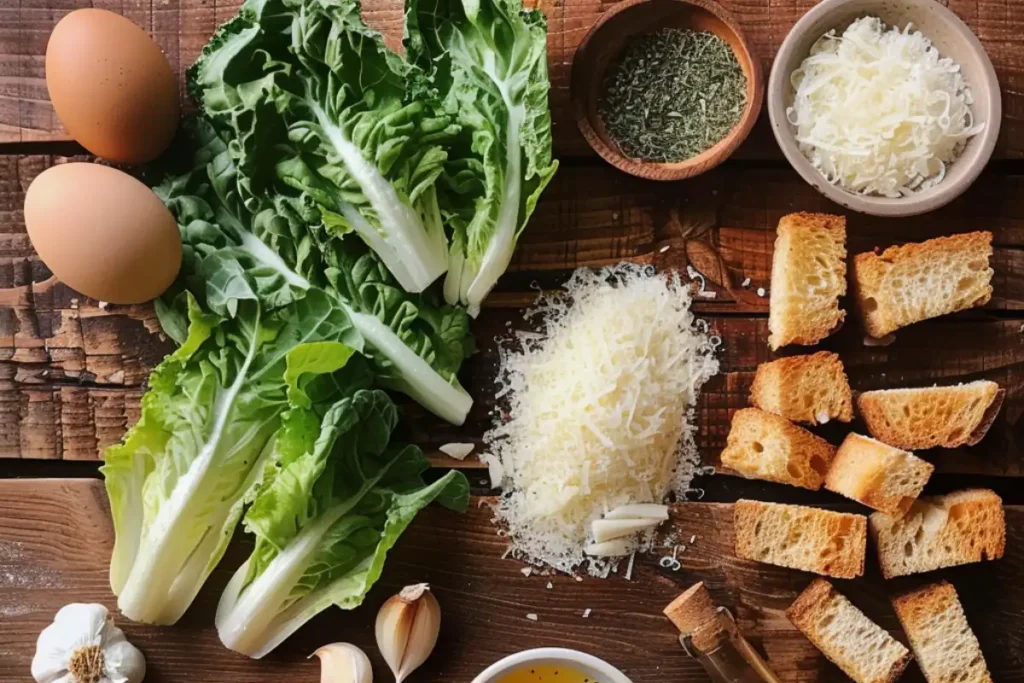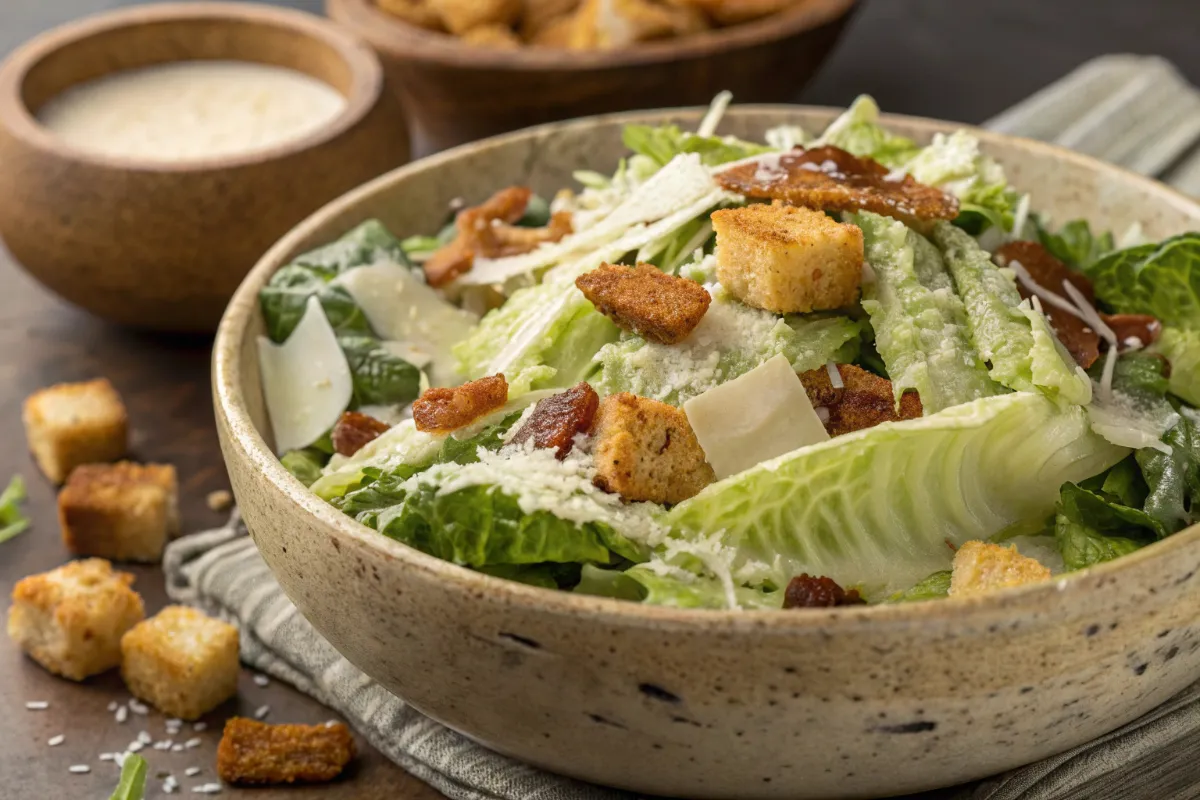The Caesar salad is an iconic dish recognized across the globe for its fresh crunch, savory flavors, and creamy dressing. Despite its Italian-sounding name, the Caesar salad was actually created in Tijuana, Mexico, by Caesar Cardini in the 1920s. Since its inception, the dish has evolved, but its original simplicity is what made it timeless. The question remains, though: What exactly were the original Caesar salad ingredients?
In this article, we’ll explore the origins of the Caesar salad, the original Caesar salad ingredients, how the dish evolved over time, and why it continues to hold a special place in culinary history.
Table of Contents
The Origins of Caesar Salad
The story of the Caesar salad begins not in Italy, but in Tijuana, Mexico, during the Prohibition Era (1920–1933). During this period, many Americans crossed the border into Mexico to enjoy nightlife, food, and drinks that were otherwise illegal in the United States. It was in this context that Caesar Cardini, an Italian-American restaurateur, created his namesake dish using what would become the original Caesar salad ingredients—Romaine lettuce, croutons, Parmesan cheese, olive oil, raw egg yolk, lemon juice, Worcestershire sauce, and garlic—on July 4, 1924.
Cardini’s use of these original Caesar salad ingredients came from necessity. On a busy holiday weekend, his kitchen ran low on supplies, and he had to improvise. His creativity resulted in a dish that quickly became a global phenomenon.
What Were the Original Caesar Salad Ingredients?

The original Caesar salad ingredients were simple but carefully selected to create a perfectly balanced dish. Here’s a closer look at what made up the legendary recipe:
- Romaine Lettuce: Unlike today’s chopped versions, the original salad featured whole leaves of Romaine lettuce. These large leaves were served uncut to allow diners to pick them up with their fingers.
- Croutons: Made from bread toasted in olive oil and garlic, the croutons provided the salad with a crunchy texture.
- Parmesan Cheese: Shaved Parmesan added a nutty, salty element that balanced the richness of the dressing.
- Olive Oil: Used to create the creamy dressing, olive oil was one of the key components that helped emulsify the mixture.
- Raw Egg Yolk: The raw egg yolk in the dressing provided the richness and creamy texture that made the salad stand out.
- Lemon Juice: This ingredient provided a tangy acidity that cut through the richness of the egg yolk and olive oil, bringing balance to the dressing.
- Worcestershire Sauce: Worcestershire sauce added a subtle umami flavor, giving the dressing a complex depth.
- Garlic: Crushed garlic infused the dressing with bold, aromatic flavors, tying the whole dish together.
Each ingredient in the original Caesar salad ingredients list played a crucial role in creating a dish that was fresh, tangy, and indulgent.
For a modern twist on the original Caesar salad, explore the Mexican Caesar Salad Recipe, which adds a bit of flair while staying true to its roots.
How to Make the Original Caesar Salad at Home

To experience the taste of the original Caesar salad, here’s a step-by-step recipe:
Ingredients:
- 1 head Romaine lettuce
- 1/4 cup olive oil
- 1 egg yolk
- 1 tbsp lemon juice
- 1 tsp Worcestershire sauce
- 1 clove garlic, crushed
- 1/4 cup Parmesan cheese, shaved
- 2 slices bread (for croutons)
- Salt and pepper to taste
Instructions:
- Make the Croutons: Cut the bread into cubes and toss with olive oil and garlic. Toast until golden and crispy.
- Prepare the Dressing: In a bowl, whisk together the egg yolk, olive oil, lemon juice, Worcestershire sauce, garlic, and salt until the dressing emulsifies into a creamy consistency.
- Assemble the Salad: Toss the whole Romaine leaves in the dressing until well coated.
- Add the Toppings: Sprinkle the croutons and shaved Parmesan on top.
- Serve: Serve immediately with freshly cracked black pepper.
For those looking to make their own croutons at home, check out this guide on How to Make the Perfect Homemade Croutons for tips on achieving the ideal crunch to complement the original Caesar salad ingredients
Modern Variations of the Caesar Salad
Over the years, the original Caesar salad ingredients have been modified and expanded upon. Some of the most popular variations include:
- Grilled Chicken Caesar Salad: Adding grilled chicken turns the Caesar salad into a heartier meal, making it a popular lunch or dinner option.
- Bacon Caesar Salad: The addition of crispy bacon brings a smoky, savory flavor that complements the tangy dressing.
- Avocado Caesar Salad: The creamy texture of avocado adds a rich element to the salad without overwhelming the classic flavors.
- Kale Caesar Salad: For a healthier twist, some modern versions use kale instead of Romaine lettuce, providing additional nutrients and a more robust flavor.
- Vegan Caesar Salad: To accommodate dietary restrictions, some versions replace the raw egg yolk with cashew cream or avocado, creating a vegan-friendly Caesar salad that retains its creamy texture.
Despite these variations, many restaurants still honor the original Caesar salad ingredients by preparing the dressing tableside, just as Cardini did nearly a century ago.
For a heartier pairing, consider serving your Caesar salad alongside Smoked Mac and Cheese, which adds a rich, smoky contrast to the crisp textures and tangy flavors
The Enduring Legacy of the Original Caesar Salad
Why the Original Caesar Salad Ingredients Still Matter
The original Caesar salad ingredients created a dish that has stood the test of time. The crisp Romaine, creamy dressing, crunchy croutons, and bold Parmesan blend perfectly to create a salad that remains a favorite worldwide.
Its simplicity allows for endless adaptations, yet the core elements continue to influence chefs and home cooks alike. Whether served as a side dish or a main course, the Caesar salad’s influence is undeniable.
If you're looking for a delicious accompaniment, consider What is a Good Side Dish for Shrimp Pasta?, which offers ideas for pairing flavors that complement the crisp textures and bold flavors of the original Caesar salad .
The original Caesar salad ingredients created a dish that has become a culinary classic. These simple yet bold components formed a perfect balance of textures and flavors, making the Caesar salad a beloved favorite around the world. Whether enjoyed in its traditional form or with modern variations, the original Caesar salad ingredients continue to influence and inspire chefs and food lovers alike.
By understanding its origins and appreciating the care that went into crafting the original recipe, we can better enjoy this timeless dish. Whether served tableside or prepared at home, the legacy of the original Caesar salad ingredients lives on, proving that great flavors never go out of style.
FAQs About the Caesar Salad
What was in the original Caesar salad?
- The original Caesar salad included Romaine lettuce, croutons, Parmesan cheese, olive oil, raw egg yolk, lemon juice, Worcestershire sauce, and garlic.
Was the original Caesar salad vegetarian?
- While mostly vegetarian, the inclusion of Worcestershire sauce, which traditionally contains anchovies, means the original recipe was not strictly vegetarian.
Is the Caesar salad from Italy?
- No, the Caesar salad was created by Caesar Cardini, an Italian-American restaurateur, in Tijuana, Mexico.
Why was raw egg used in the original recipe?
- The raw egg yolk helped emulsify the olive oil and lemon juice, giving the dressing a creamy, rich texture.
Original Caesar Salad
This Original Caesar Salad is a timeless classic featuring crisp romaine lettuce, crunchy croutons, Parmesan cheese, and a rich, homemade Caesar dressing. Simple yet elegant, this salad is the perfect side dish or light meal! 🥗🧀✨
- Prep Time: 10 minutes
- Total Time: 10 minutes
- Category: Lunch
- Method: No-Cook
Ingredients
For the Salad:
- 1 large head Romaine lettuce, chopped
- 1 cup croutons (homemade or store-bought)
- ½ cup freshly grated Parmesan cheese
For the Classic Caesar Dressing:
- ½ cup extra virgin olive oil
- 1 large egg yolk (or 1 tbsp mayonnaise as a substitute)
- 1 tbsp Dijon mustard
- 2 cloves garlic, minced
- 1½ tbsp lemon juice (freshly squeezed)
- 1 tsp Worcestershire sauce
- 2 anchovy fillets, mashed (or ½ tsp anchovy paste)
- ½ tsp salt
- ¼ tsp black pepper
Instructions
-
Make the Dressing:
- In a medium bowl, whisk together egg yolk, Dijon mustard, garlic, lemon juice, Worcestershire sauce, anchovies, salt, and pepper.
- Slowly drizzle in olive oil, whisking continuously until emulsified and creamy.
-
Assemble the Salad:
- In a large bowl, toss Romaine lettuce with Parmesan cheese and croutons.
- Drizzle with the Caesar dressing and toss gently until well coated.
-
Serve & Enjoy:
- Plate immediately and top with extra Parmesan cheese if desired.
Notes
- For a creamier dressing, blend ingredients in a food processor.
- For extra flavor, add a pinch of red pepper flakes or freshly cracked black pepper.
- For a grilled twist, serve with grilled chicken or shrimp.


